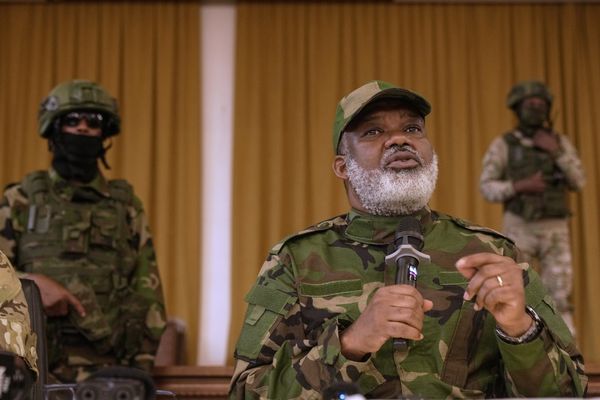
As an athlete it’s all about how fast you move—how hard you can swing, throw, or kick, and how high you can jump. What you wear either hinders or improves those things. How does the world’s largest athletic apparel company design clothing that actually enhances the performance of an athlete? How does it create the bridge that connects technology with design? At Nike, that job is designated to the Apparel Innovation department, which partners with The Nike Sport Research Lab (NSRL), the very epicenter of human performance data and knowledge that helps the company create apparel that removes any limits that keep each individual from doing his or her best. The Apparel Innovation team—helmed by Janett Nichol, the VP of Apparel Innovation—works with the NSRL, which has the capability to assess every aspect of the human body in relation to sports, in turn breaking down barriers to sport. It can measure just how much a body moves before it starts sweating profusely or experiences fatigue.
“The athletes are at the center of everything we do,” said Nichol the day after Nike held a massive presentation to unveil the Women’s World Cup kits and to celebrate the female athlete. “What happens is we bring the athletes into the lab and we run a number of tests on our athletes. And that allows us to have a deep, deep knowledge around many, many athletes around the world. And it’s through that data that we’re able to discern certain things. It could be that we have an athlete running on the track and we recognize that this particular athlete perspires at this number or mile marker in his race and he perspires in this area, and at a certain mile marker the sweat accelerates or decelerates. We learn all different sorts of interesting things.”
When Nichol started out as a designer at Nike 26 years ago as, the company was just starting to focus on its female customer. As Nike became more established in the ‘70s, the United States Congress passed Title IX, enforcing gender equality in high school and collegiate sports. In the ‘80s, it celebrated French runner Joan Benoit Samuelson, who became the first woman to win gold in the first women’s marathon at the 1984 Olympic Games in Los Angeles, through a series of advertisements. In 1995, just a few years after Nichol started at Nike as a designer for collegiate basketball, basketball player Sheryl Swoopes would become the first woman (and the second athlete after Michael Jordan) to earn a Nike sneaker bearing her name. That same year, Nike released the “If You Let Me Play” campaign, which touted the positive benefits of sports for girls. Just four years later, the United States would win the 1999 Women’s World Cup, and Nike took the opportunity to further inspire a new generation of female athletes. Then in 2004 Nike tapped Serena Williams, who would amass 39 (and counting) major titles in tennis, and, earlier this year, narrate the Dream Crazier campaign. “When we put that through the lens of women, one of the things we do is we focus on really specific areas of women because we’ve recognized how different they are from men,” said Nichol, referring to Nike’s focus on apparel innovation and the NRSL.
Nike believes that if you have a body, you are an athlete. So, one of the baseline tests athletes do when entering the NRSL is to go inside the lab’s 3D scanner, and stand in the center. Then, hundreds of cameras (126 to be exact) will photograph every single inch of the athlete’s body. After, a highly accurate, 360-degree 3D model of the athlete is created. From there, Nike combines the scan with data such as areas of high heat, sweat, cooling to allow designers to create apparel based on the athlete’s exact needs. But that’s just one small part of the equation. Nike’s NSRL team consist of researchers—many of whom hold doctorates or master’s degrees in a wide range of scientific disciplines including biomechanics, physiology, biomedical engineering, mechanical engineering, physics, math, kinesiology, systems science, and others—who test countless ideas in pursuit of improving performance, reducing injury risk, enhancing perception and feel, and delivering innovative products to athletes. The rest of the information comes from the athlete, adding an aspect of human connection to the product.
“When we talk to athletes, it’s not always about, ‘Tell me how your garment feels or how your footwear feels,’” said Nichol. “A lot of times our conversations can be quite personal, right, and they can get, especially with women, they can get to the level of, ‘I never knew I could do this.’ Or, ‘I’ve always aspired to do this.’ Or, ‘I was motivated or moved to do something.’ And it gets to a different kind of a conversation, and then sometimes it’s through those conversations that you start to understand, and even with men, because when I used to work with a lot of basketball players, I would get these sorts of conversations happening, you start to understand the power of the product that we build.”
With sport comes emotion, and Nichol has witnessed some of the biggest athletes reaching emotional highs and lows, including the first time basketball players Allen Iverson and Ray Allen laid eyes on their collegiate uniforms in 1993 when they played at Georgetown and UConn. “I’ve had experiences where athletes have talked to me about the desire to be at a certain level for many, many years, and you finally arrive, and you get to your locker room and you get that gym bag and you open it up, and you can’t believe that you have your own shoe and you have your own jersey, and it has your name on the back and it’s got a swoosh on the front,” said Nichol. “I’ve literally been in front of athletes where there were tears in your eyes, and it gets you.”

It was the stories of defeat that struck Nichol the most, especially the ones she heard while developing the Nike FE/NOM Flyknit bra, a sustainable sports bra made with recycled yarn that minimizes the material that goes into making the strap, the underwire, and the padding. “It was sad to listen to women talk to us who said that, ‘I had to quit playing sports because I couldn’t find a bra that fit me.’ And so that’s where you start to realize women, in particular, will opt out of sports because at some point, she either feels insecure or she doesn’t want to be seen because when you’re going from 10, 11 and you start to change, it feels a little too much.” That left the bra team to answer the question: “How do we ensure that we create a sport bra that truly allows for all women to engage in sport?” Now the team has a sports bra in the works that will go up to a 44D.

Nike also became the first athletic apparel company to release a hijab with the Nike Pro Women’s Hijab, which has been worn in competition by American champion fencer Ibtihaj Muhammad and German boxer Zeina Nassar. Its development was a team effort between the designers and athletes that created a project that adhered to cultural conventions while being durable enough for sports. “We were definitely engineering it for sport. And we also wanted to make sure that it worked for her, especially in very humid climates,” said Nichol. “So that it was breathable, it was lightweight, there was adequate coverage.“
As for cultural sensitivity, after highly publicized gaffes by Prada, Gucci, and Moncler—Nichol, who is one of the rare executives of color in fashion, emphasized the importance of creating products specifically targeted for certain markets. “We’re looking at the whole body when we’re looking at fit. And we recognize that even in different parts of the world, we are shaped different, right? So I can be in a region and people have a certain fit. And even, obviously, within the people there there’s differences.” Nichol stressed that Nike is very mindful of the work it does around the world, and that they have communications and community teams globally—as well as a vast network of athletes—with whom to consult should a question or concern arise.
After the scientific data and personal information is collected, computational design comes into play, combining science with art, that is then put through a system that uses algorithms and design. “It is phenomenal,” said Nichol. “You’re going to see some things that are going to blow your mind because it’s just so beautiful what it’s able to do.”
But Nichol maintains that Nike’s success—it is one of the largest apparel brands in the world—is in its ability to hear out what the athletes have to say.
“I really believe in the model that we have, which is listening to the voice of the athlete,” said Nichol. “And the reason why we go that way is because every voice is different. And I know for me personally, I want to make sure I’m listening to every voice. Because it’s amazing what you can hear if you just listen.”







